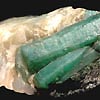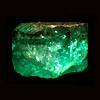- sale
- new items
- lovely beads
- wedding beads
- beads for teens
- for custom order
- newsletter
- recognition
- testimonials
- birthstones
- zodiac signs
- jewelry guide
SHOP BAG
![]() in your bag 0 items
in your bag 0 items
A gemstone of May is malachite, another gem of this month is emerald. Emerald are a green colored variety of the mineral beryl. Most emeralds are highly included, so their brittleness (resistance to breakage) is classified as generally poor. The word "emerald" comes from Latin SMARAGDUS, via Greek SMARAGDOS, its original source being a Semitic word IZMARGAD or the Sanskrit word, MARAKATA, meaning "emerald" or "green".
Emeralds, like all colored gemstones, are graded using four basic parameters, the four Cs of Connoisseurship; Color, Cut, Clarity and Crystal (the last C, crystal is simply used as a synonym that begins with C for transparency). Emeralds occur in hues ranging from yellowish green to bluish green, but the primary hue must, of course, be green. Only gems that are medium to dark in tone are considered emerald. Light toned gems are known by the species name, green beryl. A fine emerald must possess not only a pure verdant green hue, but also a high degree of transparency to be considered a top gem. Unlike diamond, emerald clarity is graded by eye: if an emerald has no visible inclusions to the eye it is considered flawless.
Emeralds in antiquity were mined by the Egyptians and in Austria, as well as Swat in northern Pakistan. A rare type of emerald known as a trapiche emerald is occasionally found in the mines of Colombia. It is named for the trapiche, a grinding wheel used to process sugarcane in the region. Colombian emeralds are generally the most prized due to their transparency and fire.
Some of the most rare emeralds come from three main emerald mining areas in Colombia: Muzo, Coscuez, and Chivor. Fine emeralds are also found in other countries, such as Zambia, Brazil, Zimbabwe, Madagascar, Pakistan, India, Afghanistan and Russia. In the US, emeralds can be found in Hiddenite, North Carolina. In 1998, emeralds were discovered in the Yukon.
The emerald has been a gem of fascination in many cultures for over six thousand years. The earliest reference to emeralds in Western literature come from Aristotle; he stated "An emerald hung from the neck or worn in a ring will prevent the falling sickness (epilepsy). We, therefore, commend noblemen that it be hanged about the necks of their children that they fall not into this complaint."
Throughout history, emeralds have been prized and worn by royalty and celebrities. It was known that emerald was a favorite gem of Cleopatra, the Queen of Egypt, and the Emerald mine in Upper Egypt, rediscovered a hundred years ago near the Red Sea, was one of the earliest emerald occurrences in the human history. In the first century BC, Ptolemy, the King of Egypt, had an emerald engraved with the portrait of Lucullus, the great Roman general. He then presented it to him when Lucullus visited Egypt.
Alexander the Great had a large emerald set into his girdle. Charlemagne had a collection of emeralds, and Henry II, when he was made King of Ireland in 1171, was given a large emerald ring. Queen Elizabeth II had an amazing collection of emerald jewelry. Marlene Dietrich wore her own collection of dramatic jewelry set with huge cabochon emeralds in many of her movies. Grace Kelly was given a 12 carat emerald-cut diamond engagement ring from Prince Rainier. And that's not the full story...



